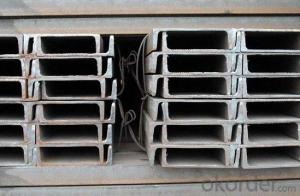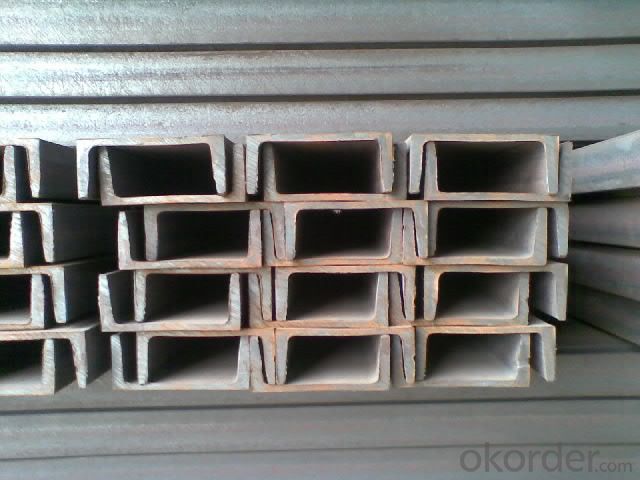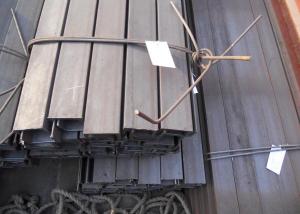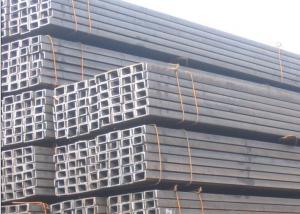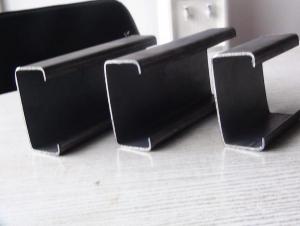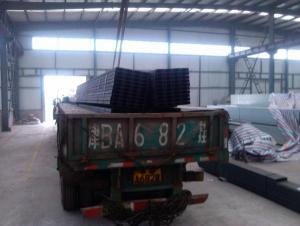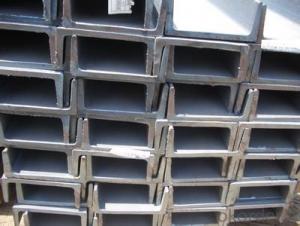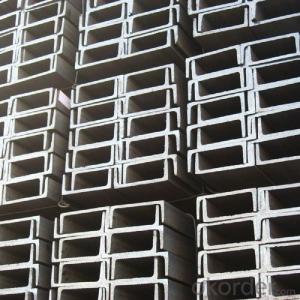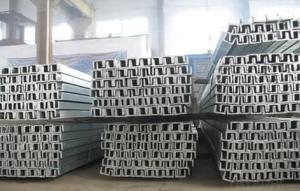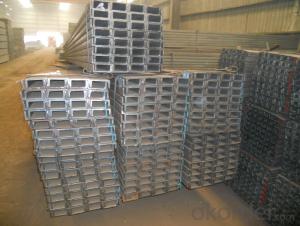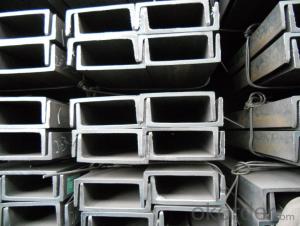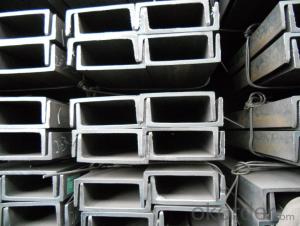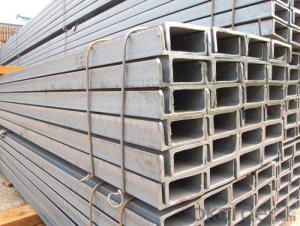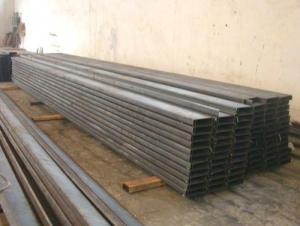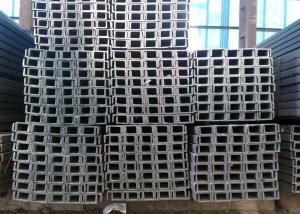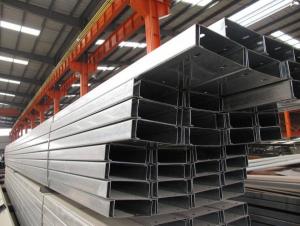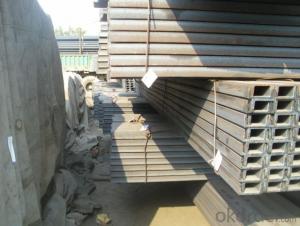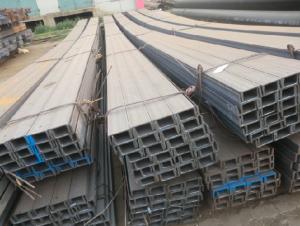High Quality Steel Channel 150mm
- Loading Port:
- China Main Port
- Payment Terms:
- TT OR LC
- Min Order Qty:
- -
- Supply Capability:
- -
OKorder Service Pledge
OKorder Financial Service
You Might Also Like
Steel Channel
Standard: JIS
Material: SS400
Length: 6m, 12m
Size:
| Size (mm) | Mass (Kg/m) |
| 150*75*5.5 | 14.66 |
| 150*75*6.0 | 17.90 |
| 150*75*6.5 | 18.60 |
Package & Delivery of Steel Channel:
1.The hot rolled channel steel will be packed in bundle with steel wire at each end of every bundle and color marking in order to help the customer to recognize his goods more easily at sight.
2. And the hot rolled channel steel could be loaded into 20ft or 40ft container, or by bulk cargo.If the weight of each bundle reaches more than 3.5 mt, the loading by break bulk cargo should be choosed.When the weight of each bundle reaches less than 3mt, the loading by container should be choosed.
3.As for the transportaion from mill to loading port, the truck will be usually used. And the maximum quantity for each truck is 40mt.
4.All in all, we could do in accordance with customer's request.
Production Flow of JIS Channel:
1.The steel billet shall be heated in the high temperature furnace.
2. The heated steel billet shall be rolled five to nine times with the aim of shaping the general figure of steel u channel.
3. The rolled steel channel should be put onto the cooling bed to make the temperature low.
4. The JIS Channel should be straighted on the straightener.
5. The straighted steel u channel will be cut into meters by saw, as per customer's requirements.
6. At the last part of production, the channel steel must be tested in order to confirm that the finished products are completely free from crack, pore, slag, scab or fold on the surface.
*If you would like to get our price, please inform us the size, standard/material and quantity. Thank you very much for your attention.
- Q: Can steel channels be used for access ladders?
- Access ladders can indeed utilize steel channels. The construction industry frequently employs steel channels due to their exceptional strength and durability. By welding or bolting them together, a robust ladder structure can be effortlessly created. Moreover, steel channels offer stability and support, rendering them appropriate for use as access ladders. Furthermore, their resistance to corrosion makes them well-suited for outdoor or industrial settings where moisture or chemicals may be present. Nonetheless, it is crucial to verify that the steel channels employed for access ladders comply with the required safety standards and regulations to guarantee user safety.
- Q: Are steel channels suitable for historical restoration projects?
- Yes, steel channels can be suitable for historical restoration projects. Steel channels provide strength, durability, and versatility, making them ideal for recreating or replacing structural elements in historical buildings. Additionally, their ability to be fabricated to specific dimensions allows for precise replication of original designs. However, careful consideration should be given to ensure that the use of steel channels aligns with the historical significance and integrity of the building in question.
- Q: How do steel channels contribute to natural ventilation?
- Steel channels can contribute to natural ventilation in several ways. Firstly, steel channels can be used to create air vents or openings in buildings. These vents allow fresh air to enter the building and circulate, helping to remove stale air and improve indoor air quality. The channels can be strategically placed to maximize airflow and create a natural flow of air. Additionally, steel channels can be used to create louvers or slats in windows or facades. These louvers allow for adjustable ventilation, allowing occupants to control the amount of air entering the building according to their preference. By adjusting the position of the louvers, the flow of air can be directed towards specific areas or rooms, providing targeted ventilation where it is needed most. Moreover, steel channels can be used to create chimneys or exhaust vents. These structures help to expel hot air, smoke, and other pollutants from the building, promoting a healthier and more comfortable indoor environment. By creating a vertical airflow, the channels help to remove heat build-up and improve air circulation, which is especially beneficial in spaces with high humidity or where odors and contaminants may be present. Overall, steel channels play a crucial role in natural ventilation by providing openings, louvers, and exhaust vents that facilitate the movement of air. By harnessing natural forces such as wind and thermal buoyancy, these channels help to create a sustainable and energy-efficient ventilation system that improves the comfort and well-being of building occupants.
- Q: How do steel channels contribute to the overall strength of a building?
- Steel channels contribute to the overall strength of a building by providing structural support and reinforcement. They are commonly used in construction to transfer loads and distribute weight evenly across different parts of the structure. Steel channels help to prevent sagging, bending, and collapse by increasing the stability and rigidity of the building. Additionally, they enhance the building's resistance to lateral forces such as wind or earthquakes, making it more durable and structurally sound.
- Q: Are steel channels suitable for use in the construction of utility poles?
- Yes, steel channels are suitable for use in the construction of utility poles. Steel channels are known for their strength and durability, making them an excellent choice for supporting utility poles. They can withstand heavy loads and adverse weather conditions, ensuring the stability and longevity of the utility poles. Additionally, steel channels have high resistance to corrosion, which is crucial for utility poles that are often exposed to moisture and harsh environmental elements. Moreover, steel channels can be easily fabricated and customized to meet specific design requirements, allowing for flexibility in utility pole construction. Overall, steel channels provide a reliable and efficient solution for constructing utility poles, making them a suitable choice in the construction industry.
- Q: Calculated weight of channel steel
- A calculating example channel (kg/m) W=0.00785 * [hd+2t (B? C D (+0.349) R2? C R 2 m h=) per channel] weight high b= leg length d= t= average thickness of R= thick waist leg inner arc radius r= end arc radius for 80 mm * 43mm * 5mm. From the metallurgical products directory found the channel of T is 8, R is 8, R is 4, per M weight =0.00785 * [80 * 5+2 * 8 * (43? 5 C) * +0.349 (82? C4 2)]= 8.04kg
- Q: Can steel channels be used for facade cladding systems?
- Yes, steel channels can be used for facade cladding systems. Steel channels provide structural support and can be used as framing components for attaching cladding materials such as glass, metal panels, or composite materials. They offer durability, strength, and versatility, making them suitable for various facade designs and applications.
- Q: What is the difference between U steel and channel steel?
- Channel steels and U steels are simply different when applied,Mainly divided into ordinary channel (U steel) and light channel (light U steel).It can also be considered as follows: the channel steel is formed by thermal elongation, and the U steel is generally rolled under cold condition.The biggest difference between the two is thickness: the overall thickness of the channel is not the same, the overall thickness of light U steel is the same
- Q: What are the different finishing techniques for steel channels?
- Steel channels have multiple options for finishing techniques that enhance their appearance and protect against corrosion. One widely used technique is galvanizing, which involves applying a thin layer of zinc to the channels. This zinc coating provides excellent corrosion resistance and can be applied through hot-dip galvanizing or electroplating. Galvanized steel channels have a distinct silver-gray look. Another option is powder coating, where a dry powder is applied to the channels and then baked to create a durable and decorative finish. Powder coating comes in various colors and provides a smooth and even coating. Painting is also commonly used, with liquid paint applied to the channels through brushing, spraying, or dipping. This not only improves appearance but also acts as a protective barrier against corrosion. Polishing and brushing are additional techniques that create smooth and shiny or textured surfaces, respectively. Polishing removes imperfections and produces a reflective surface, while brushing uses wire brushes or abrasive pads to achieve a textured finish. In summary, there are numerous finishing techniques for steel channels, each with its own advantages and aesthetic appeal. The choice of technique depends on factors such as desired appearance, corrosion resistance needs, and cost considerations.
- Q: What kind of low carbon steel or medium carbon steel are they?
- Low carbon steel is limited in use due to its low strength. Increasing the content of manganese in the carbon steel and adding some alloying elements such as vanadium, titanium and niobium can greatly improve the strength of the steel. If the carbon content in the steel is reduced and a small amount of aluminum, a small amount of boron and carbide are added to form the element, the super low carbon bainite can be obtained, and its strength is very high and good plasticity and toughness can be maintained
Send your message to us
High Quality Steel Channel 150mm
- Loading Port:
- China Main Port
- Payment Terms:
- TT OR LC
- Min Order Qty:
- -
- Supply Capability:
- -
OKorder Service Pledge
OKorder Financial Service
Similar products
Hot products
Hot Searches
Related keywords
